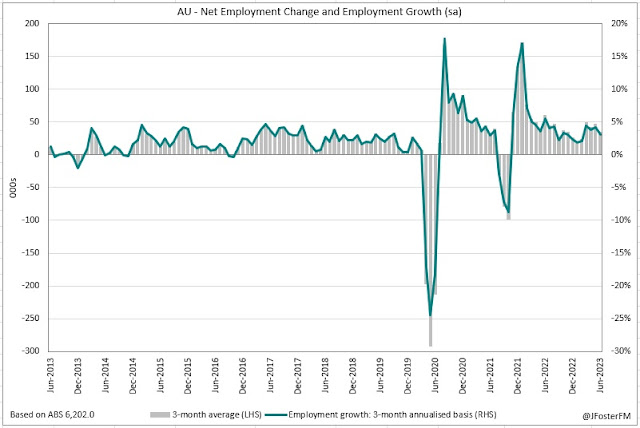Australian employment increased above expectations in June to back up May's very strong rise. Robust labour demand saw the national unemployment rate remaining around half-century lows at 3.5%, with labour force participation around record highs.
Labour Force Survey — June | By the numbers
- Employment increased by 32.6k (on net) in June, above the 15k consensus but moderating from a surge of 76.5k in May (revised up from 75.9k).
- National unemployment rate came in at 3.5%, unchanged after the rate in May was revised down in today's report from 3.6% initially reported. The broader underemployment rate remained at 6.4% while total underutilisation fell from 10% to 9.9%.
- Labour force participation rate eased off May's record high (66.9%) to 66.8% in June; however, the employment to population ratio (share of working-aged Australians in work) remained at 64.5%, its highest level on record.
- Hours worked lifted by 0.3% in June to be up by a very robust 2.9% in the quarter.
Labour Force Survey — June | The details
Renewed strength in the Australian labour market in May has extended into June, with the key details in today's report coming in on the upside of market expectations. As anticipated (see here), employment showed further strength rising by 32.6k in June following what was the largest rise in 11 months in May (76.5k). This month, full-time employment increased by 39.9k but part-time employment declined by 6.7k.
For the June quarter, employment increased by 105.3k, averaging a solid rise of 35.1k per month. While quarterly employment moderated from a very robust Q1 (149k) it far exceeded the gains from the final two quarters of 2022 (76.7k in Q3 and 78.9k in Q4). In a post-pandemic environment where inward migration has driven rapid growth in the working-age population (2.9%yr), momentum in employment growth remains solid annualising at a 3.1% pace in the June quarter.
Robust labour demand continues to underpin an unemployment rate that remains around half-century lows and a participation rate sitting on record highs. Unlike many other countries, Australia has a much higher level of labour force participation coming out of the pandemic and that has been a key factor that has contributed to more moderate wage pressures and ultimately lower interest rates relative to offshore.
Monthly hours continue to show a volatile profile; however, June's rise (0.3%) left hours worked up by a sharp 2.9% for the quarter. That compares to a weak outcome in the March quarter (-0.2%).
Labour Force Survey — June | Insights
Today's report reflected a continuation of momentum in the labour market after it found renewed strength in May. Although the RBA kept rates on hold earlier this month, the Board's guidance reflects a willingness to tighten further. Given May's very strong labour market report did not prompt a hike at the July meeting, it appears the Board is awaiting next week's Q2 CPI data before deciding on its next move.









